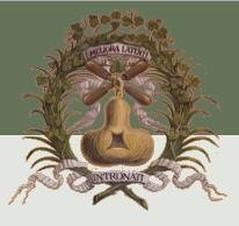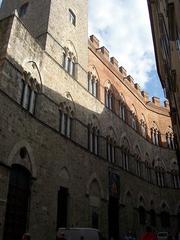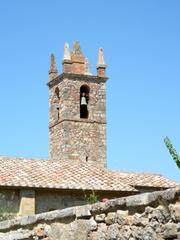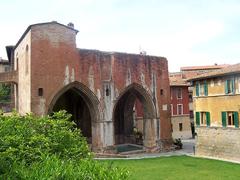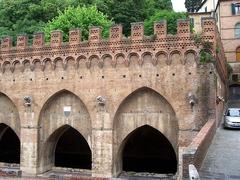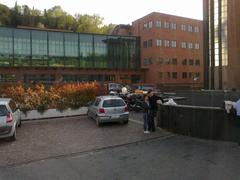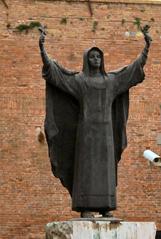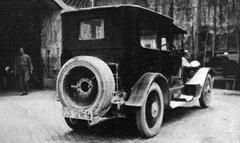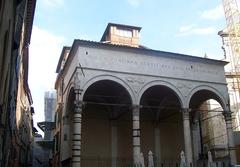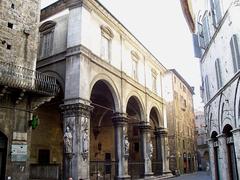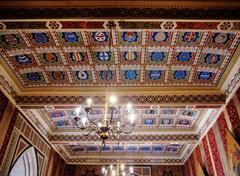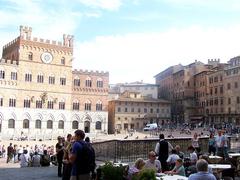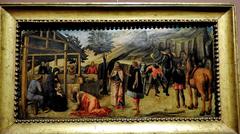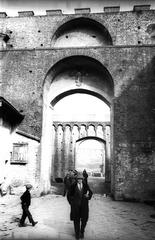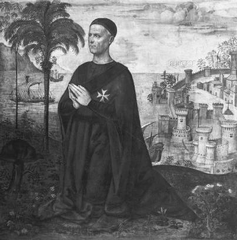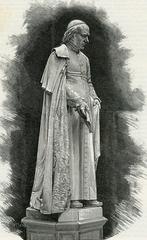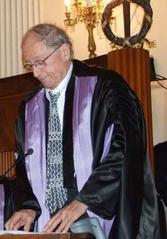Museo della Contrada della Chiocciola: Visiting Hours, Tickets, and Siena Historical Sites Guide
Date: 14/06/2025
Introduction
The Museo della Contrada della Chiocciola, located in the heart of Siena’s historic center, offers an immersive journey through the city’s centuries-old contrada system. The Contrada della Chiocciola, symbolized by the golden snail, is one of Siena’s 17 distinctive neighborhoods. Its museum, housed in the crypt of the 17th-century Chiesa dei Santi Pietro e Paolo, displays sacred art, Palio memorabilia, and artifacts that bring to life the rich cultural, religious, and communal traditions of the Chiocciolini (oksiena.it; Museionline; Visit Tuscany). This detailed guide presents essential visitor information, travel tips, the museum’s highlights, and its significance within Siena’s vibrant community.
Contents
- Siena’s Contrada System: History and Social Role
- Museo della Contrada della Chiocciola: Setting and Architecture
- Museum Collections: Highlights and Heritage
- Visitor Information: Hours, Tickets, and Accessibility
- How to Get There and Travel Tips
- Nearby Siena Historical Sites and Attractions
- Visitor Experience and Special Events
- Frequently Asked Questions (FAQ)
- Conclusion and Recommendations
Siena’s Contrada System: History and Social Role
Siena’s contrade are not merely administrative districts; they are living communities that shape the city’s identity. Originating as military and administrative units in the Middle Ages, the 17 contrade evolved into robust social organizations, each with its own emblem, traditions, and governing bodies (siena-guide.com). Membership is typically inherited, and the contrada offers social support, education, and a sense of belonging across generations. The Contrada della Chiocciola is especially known for its tight-knit community and devotion to tradition, with annual celebrations and active participation in the iconic Palio di Siena.
Museo della Contrada della Chiocciola: Setting and Architecture
Housed in the crypt beneath the Chiesa dei Santi Pietro e Paolo on Via San Marco, 37, the museum forms part of the former Monastery of San Paolo (palazzoravizza.it; Museionline). The transformation into a museum was completed in 1981, under the direction of sculptor Pierluigi Olla and architect Adriano Perra. The interior artfully blends original monastic features with bespoke wooden display cases crafted by Bernardino Barbetti’s workshops (Musei Senesi). The ceiling is adorned with wooden coats of arms—some imaginative, some historical—representing the families who sustained the Contrada.
Museum Collections: Highlights and Heritage
Sacred Vestments and Liturgical Treasures
The museum’s core collection features sacred vestments, such as a gold-laminated chasuble once owned by Pope Pius VI and left in Siena during his 1798 exile (Musei Senesi). Additional highlights include copes, stoles, dalmatics, and altar frontals, many embroidered with Chiocciola motifs. The oldest textile—an embroidered stole—dates back to the 16th century.
Liturgical Furnishings and Silverware
Notable pieces include a 17th-century gilded wooden lectern decorated with the symbols of the Evangelists and the Chiocciola emblem, a 1673 silver chalice gifted by priest Camillo Coralli, and intricately decorated ostensories and pyxes.
Unique Artifacts
- Raganella (1661): A rare wooden noisemaker used during Holy Week.
- Wooden Key Holder (1799): Painted in Contrada colors.
- Charity Box (19th century): Used for alms for souls in purgatory.
- Original Bell (1691): From the Contrada’s earliest oratory.
Palio Banners and Costumes
The Sala delle Vittorie displays Palio banners (drappelloni) and costumes from historic parades, including award-winning ensembles from 1878, 1904, 1925, and 1957 (Visit Siena Official; Terre di Siena).
Visitor Information: Hours, Tickets, and Accessibility
- Location: Via San Marco, 37, Siena, Italy (Museionline)
- Opening Hours: Visits are typically by appointment and on select weekends or during contrada festivals. Usual hours are 10:00–13:00, with occasional afternoon sessions. Always check the official Contrada or museum website for up-to-date schedules.
- Tickets and Admission: Admission is free but requires advance booking—contact via WhatsApp (+39 338 2130462) or through the official website.
- Guided Tours: Available in Italian and English upon request, often included with your reservation.
- Accessibility: The museum has a single-level layout but, as a historic crypt, may pose challenges for visitors with reduced mobility. Contact the museum in advance for assistance.
- Photography: Policies may vary; ask staff before photographing exhibits.
How to Get There and Travel Tips
- On Foot: Easily walkable from Piazza del Campo (approx. 10 minutes).
- By Public Transport: Siena’s city buses stop near the historic center; check local schedules.
- By Car: Park in the designated garages outside the city walls (San Francesco or Il Campo); expect a 10–15 minute walk.
- By Train or Bus: Arrive at Siena station (2 km from center); take a local bus, taxi, or walk through the scenic streets (Siena Visitor).
- Best Time to Visit: Outside Palio race days to avoid crowds, unless you wish to experience festival atmosphere.
Nearby Siena Historical Sites and Attractions
- Piazza del Campo: Site of the Palio di Siena.
- Siena Cathedral (Duomo di Siena): Renowned for its Romanesque-Gothic architecture.
- Palazzo Pubblico and Torre del Mangia: City hall and panoramic tower (palazzoravizza.it; Siena Visitor).
- Basilica di San Domenico: A short walk away (Siena Visitor).
- Orto Botanico di Siena: Siena’s botanical garden (Siena Visitor).
Visitor Experience and Special Events
The museum is more than a static collection; it is a living institution embedded in community life. It frequently serves as a venue for:
- Festa Titolare: Late June festival honoring Saints Peter and Paul.
- Palio Periods: Extended hours, themed displays, and special events.
- Cultural Programming: Music series, journalism festivals, and ecological activities for children (Contrada della Chiocciola).
- Temporary Exhibitions: Rotating art and photography shows.
The Contrada organizes educational initiatives for all ages, ensuring the transmission of tradition and fostering a welcoming, vibrant environment.
Frequently Asked Questions (FAQ)
Q: What are the Museo della Contrada della Chiocciola’s opening hours?
A: Visits are by appointment on select weekends and during festivals. Confirm hours via the official website or WhatsApp.
Q: Is admission free?
A: Yes. Donations are welcomed to support preservation and programming.
Q: Are guided tours available in English?
A: Yes, on request during booking.
Q: Is the museum accessible for people with disabilities?
A: The museum is on one level, but as a historic crypt, may have accessibility limitations. Contact the museum for specific needs.
Q: Can I take photographs inside?
A: Policies may vary; check with museum staff.
Conclusion and Recommendations
The Museo della Contrada della Chiocciola stands as a vibrant center of Sienese heritage, where art, devotion, and community spirit are interwoven. Its collections showcase the depth of Siena’s contrada traditions, while regular events and guided tours offer an engaging visitor experience. To maximize your visit, plan ahead by scheduling an appointment, explore nearby historical attractions, and immerse yourself in Siena’s living history.
For more insights and audio guides, download the Audiala app, and follow the Contrada della Chiocciola’s official channels for updates on events and exhibitions. Engaging with the museum is not only a journey through Siena’s past but participation in its living culture.
Source References and Further Reading
- oksiena.it
- Museionline
- Visit Tuscany
- Siena Visitor
- siena-guide.com
- palazzoravizza.it
- Musei Senesi
- Visit Siena Official
- Terre di Siena
- Contrada della Chiocciola
- Radio Siena TV – Chiocciola Section
